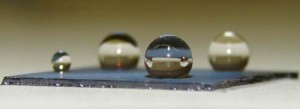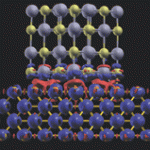Yoke Khin Yap (Physics) has received $166,750 from the US Department of Energy for the first year of a potential two-year research project totaling $333,500, “Hetero-Junctions of Boron Nitride and Carbon Nanotubes: Synthesis and Characterization.”
PI Claudio Mazzoleni and Co-PIs Raymond Shaw, Will Cantrell (Physics) and Lynn Mazzoleni (Chemistry), “Cloud-Processing of Brown and Black Carbon Aerosol from Biomass Burning: Spectroscopic, Chemical and Physical Properties—A Laboratory Study in Michigan Tech Turbulent Cloud Chamber,” NASA
Ravi Pandey (Phys) has received $75,000 (with a potential award total of $726,291) from the US Department of Defense-Army Research Laboratory for the first year of a potential three-year research and development project titled “First Principles Studies of Structure-Property Relationships in Two-dimensional Nanomaterials Beyond Graphene for Defense Applications.”
Robert Nemiroff (Phys) has received $30,000 of $238,362 from the National Aeronautics and Space Administration for the first year of a three-year project titled “Supporting Astronomy Picture of the Day.”

Professor John Jaszczak (Physics), adjunct curator at the A. E. Seaman Mineral Museum, published a paper in the September/October issue of The Mineralogical Record, “Spectacular Sulfides from the Merelani Tanzanite Deposit, Manyara Region, Tanzania.” The paper’s coauthors are Simon Harrison, Mike Keim, Mike Rumsey (Natural History Museum, London) and Michael Wise (Smithsonian Institution).
Vol. 45, No. 5 September – October 2014
Warp-Speed Raindrops
It’s a rain race out there. In the meteorological equivalent of breaking the light-speed barrier, new research shows that the smaller droplets in a rainstorm often surpass what appears to be the speed limit for rain.
“What surprised us was not so much seeing the superterminal drops,” says physicist and co-author Raymond Shaw of MTU, “but seeing the deeper, compelling patterns.” He explains that as rain falls harder, the fraction of superterminal, or speeding, small drops increases.
Read more at Science Magazine, by Phil Berardelli. This article was posted on June 12, 2009.

Further evidence for super-terminal raindrops
M. L. Larsen1, A. B. Kostinski and A.R. Jameson
DOI: 10.1002/2014GL061397
A network of optical disdrometers (including laser precipitation monitors and a 2-dimensional video disdrometer) was utilized to determine whether the recent reports of “super-terminal” raindrops were spurious results of drop breakup occurring on instrumentation. Results unequivocally show that super-terminal raindrops at small (less than 1 mm) sizes are ubiquitous, are measurable over an extended area, and appear in every rain event investigated.
Read more at Geophysical Research Letters, published by Wiley Online Library in 2014.
Confirmed: Some raindrops fall faster than they should
Five years ago, scientists reported that raindrops, especially small ones, often fall through the air much faster than they should. Some researchers have suggested that these “super-terminal” raindrops (ones traveling more than 30% faster than their terminal velocity, at which air resistance prevents further acceleration due to gravity) were fragments of larger drops that had splattered off the team’s instruments, with the smaller bits retaining the speed the larger drop had before it struck the instrument. But new research hints that the speedier-than-expected drops are the result of natural processes—and that, moreover, they make up a substantial fraction of rainfall.
Read more at Science Magazine, by Sid Perkins. This article was posted on August 26, 2014.

Fluorinated boron nitride nanotube as an ideal spin filter
Advisor: Dr. Ranjit Pati
Understanding the electronic structure and the transport property of nano scale materials is of fundamental importance, since these materials are the ultimate candidates for the future of nano technology. Several nano materials, such as quantum dots, semiconducting nano-wires, and organic molecules, have been explored both theoretically and experimentally as the components of electronic circuitry over the last two decades. Among several interesting nano materials, metal free magnetic nano materials are found to be very enticing due to the presence of magnetism in the absence of magnetic ions. Traditionally, the magnetism comes from partially occupied d and f states in the materials; however, this understanding is not always true since s and p states are found to contribute to the magnetism in the metal free magnetic materials. The main advantage of these materials is their high Curie temperature; as a result, they can be utilized in room temperature spin-electronics (spintronics). Recently, using a first-principles approach, we have demonstrated that the fluorinated boron nitride nanotube (BNNT), which is a metal-free magnetic entity, can be used as an excellent spin filter. All majority spin carriers are almost completely blocked while passing through the fluorinated BNNT channel, allowing only the minority spin carriers to pass. We have shown that the long range ferromagnetic spin ordering in fluorinated BNNTs occurs at a temperature much above room temperature.
For more information, please visit my webpage: http://www.phy.mtu.edu/~kbdhunga
By Kamal B. Dhungana
Reference:
Kamal B. Dhungana, Ranjit Pati, Fluorinated Boron Nitride Nanotube Quantum Dots: A Spin Filter. J. Am. Chem. Soc., 2014, 136, 11494–11498.
 An image by Professor Yoke Khin Yap (Physics) is highlighted in the National Science Foundation SEE (Science, Engineering and Education) Innovation blog dated Aug. 17 as the Crystal of the Week. The photo features water droplets atop a boron nitride nanotube film, which is superhydrophobic.
An image by Professor Yoke Khin Yap (Physics) is highlighted in the National Science Foundation SEE (Science, Engineering and Education) Innovation blog dated Aug. 17 as the Crystal of the Week. The photo features water droplets atop a boron nitride nanotube film, which is superhydrophobic.
PI Reza Shahbazian Yassar (ME-EM) and Co-PIs Yoke Kin Yap (Physics), Stephen Hackney (MSE), Tolou Shokuhfar (ME-EM) and Claudio Mazzoleni (Physics) were awarded $1.2 million from the National Science Foundation for “MRI: Acquisition of a High-Resolution Transmission Electron Microscope for In-Situ Microscopy Research and Education.”
 Any university involved in compute-intensive research would love to have a supercomputer at its disposal. Michigan Technological University is one of the fortunate ones to have a super-fast machine accessible by the entire research community on campus. The computer is known as “Superior” and we sat down with Gowtham S., Director of Research Computing at the University, to hear more about it.
Any university involved in compute-intensive research would love to have a supercomputer at its disposal. Michigan Technological University is one of the fortunate ones to have a super-fast machine accessible by the entire research community on campus. The computer is known as “Superior” and we sat down with Gowtham S., Director of Research Computing at the University, to hear more about it.
insideHPC: The system’s installation just had its one year anniversary. What are some of the current projects that are harnessing all of this power?
Gowtham S.: Modeling the circulation and particle transport in the Great Lakes system, multi scale modeling of advanced materials and structures, nanostructured materials for electronics, biosensing and human health implications, and unsupervised learning in Big Data and social networks are some of the on going projects that use the power of Superior. Here is the complete listing of all 30 projects.
These projects have produced nearly two dozen publications as well, and several proposals are underway for even more projects. That makes us quite happy.
Read the full interview at insideHPC.
This interview refers to three projects within the Department of Physics.
- Physics, Johana Chirinos, Investigations in ultra-high-energy cosmic ray physics
- Physics, Ranjit Pati, Computational study of charge and spin transport in nano-scale junctions from first-principles
- Physics, Ravindra Pandey, Computational studies of nanostructured materials for electronics, biosensing and human health implications
PI Claudio Mazzoleni (Physics) and Co-PIs Lynn Mazzoleni (Chem), Raymond Shaw (Physics) and Will Cantrell (Physics), “Azores Integrated Measurements (AIM): Free Tropospheric and Marine Boundary Layer Aerosol Properties at the Eastern North Atlantic Permanent ARM Facility and the Pico Mountain Observatory, Azores,” US Department of Energy.
PI Dongyan Zhang (Physics) and Co-PIs Nazmiye Yapici (Physics) and Jim Baker (IEE), “High Brightness Fluorescence Reagents for Biomedical Applications,” NSF.
PI John Diebel (IIE) and Co-PI Yoke Khin Yap (Physics), “High Brightness Fluorescence Biosensors and Chemosensors,” University of Michigan/MIIE.